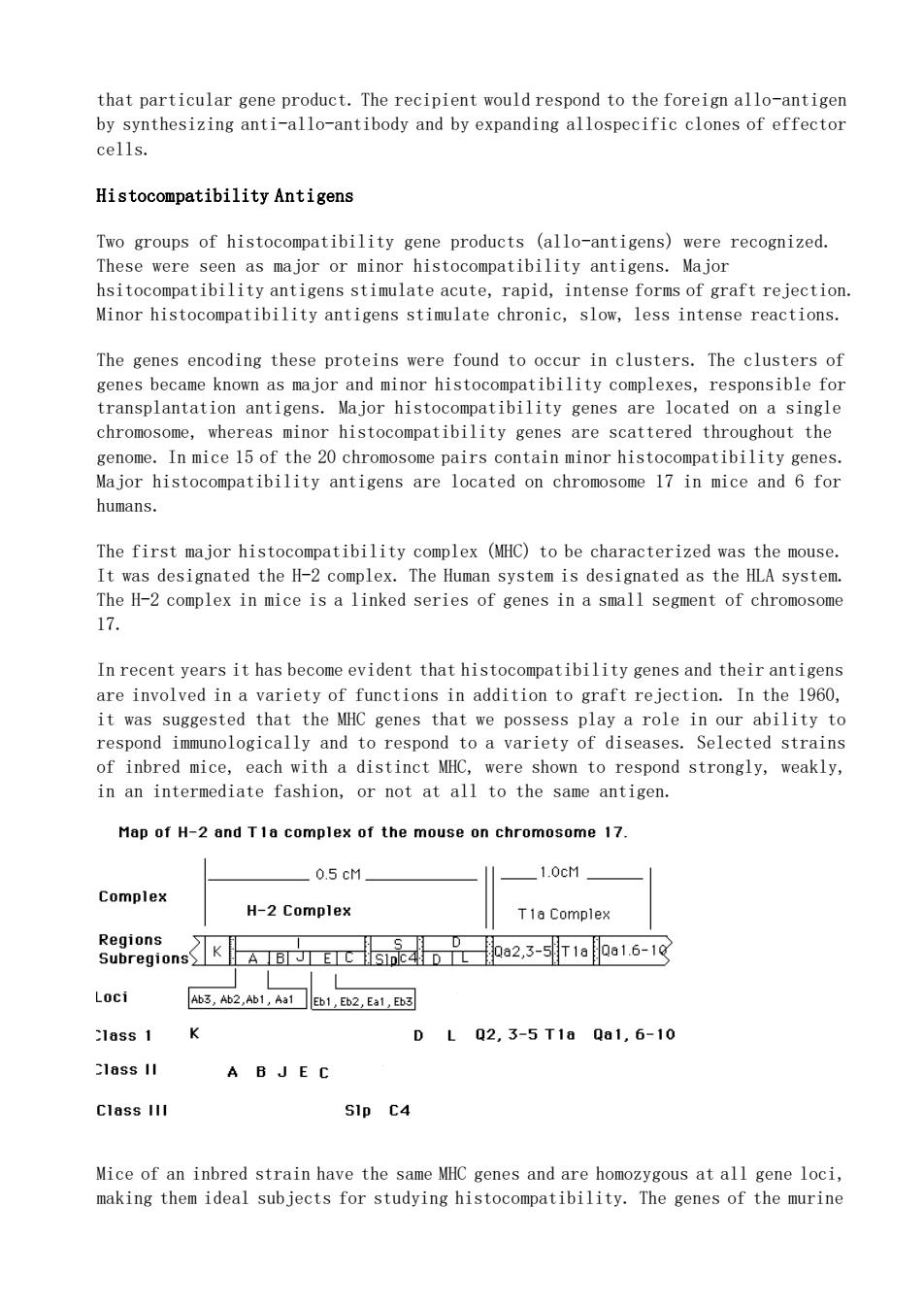正在加载图片...

that particular gene product.The recipient would respond to the foreign allo-antigen by synthesizing anti-allo-antibody and by expanding allospecific clones of effector cells. Histocompatibility Antigens Two groups of histocompatibility gene products (allo-antigens)were recognized. These were seen as major or minor histocompatibility antigens.Major hsitocompatibility antigens stimulate acute,rapid,intense forms of graft rejection. Minor histocompatibility antigens stimulate chronic,slow,less intense reactions. encoding these proteins were found to occur in clusters.The clusters of asplantation antigens.jor histocompatibility genes are located on a ecam atibility complexes,responsible fo chromosome,whereas minor histocompatibility genes are scattered throughout the genome.In mice 15 of the 20 chromosome pairs contain minor histocompatibility genes. Major histocompatibility antigens are located on chromosome 17 in mice and 6 for humans The first major histocompatibility complex (MC)to be characterized was the mouse It was designated the H-2 complex.The Human system is designated as the HLA system The h-2 complex in mice is a linked series of genes in a small segment of chromosome 17. In recent years it has become evident that histocompatibility genes and their antigens are involved in a variety of functions in addition to graft rejection.In the 1960 it was suggested that the MHC genes that we possess play a role in our ability to respond immunologically and to respond to a variety of diseases.Selected strains of inbred mice,each with a distinct MHC,were shown to respond strongly,weakly, in an intermediate fashion,or not at all to the same antigen. Map of H-2 and T1a complex of the mouse on chromosome 17. 0.5cM Complex H-2 Complex Tia Complex Loci Ab3,A62,Ab1,As1☐E®1,Eb2,E61,Eb3 class 1 K DL02.3-5T1aQa1,6-10 class I Class Ill SIp C4 Mice of an inbred strain have the same MHC genes and are homozygous at all gene loci, making them ideal subjects for studying histocompatibility.The genes of the murine that particular gene product. The recipient would respond to the foreign allo-antigen by synthesizing anti-allo-antibody and by expanding allospecific clones of effector cells. Histocompatibility Antigens Two groups of histocompatibility gene products (allo-antigens) were recognized. These were seen as major or minor histocompatibility antigens. Major hsitocompatibility antigens stimulate acute, rapid, intense forms of graft rejection. Minor histocompatibility antigens stimulate chronic, slow, less intense reactions. The genes encoding these proteins were found to occur in clusters. The clusters of genes became known as major and minor histocompatibility complexes, responsible for transplantation antigens. Major histocompatibility genes are located on a single chromosome, whereas minor histocompatibility genes are scattered throughout the genome. In mice 15 of the 20 chromosome pairs contain minor histocompatibility genes. Major histocompatibility antigens are located on chromosome 17 in mice and 6 for humans. The first major histocompatibility complex (MHC) to be characterized was the mouse. It was designated the H-2 complex. The Human system is designated as the HLA system. The H-2 complex in mice is a linked series of genes in a small segment of chromosome 17. In recent years it has become evident that histocompatibility genes and their antigens are involved in a variety of functions in addition to graft rejection. In the 1960, it was suggested that the MHC genes that we possess play a role in our ability to respond immunologically and to respond to a variety of diseases. Selected strains of inbred mice, each with a distinct MHC, were shown to respond strongly, weakly, in an intermediate fashion, or not at all to the same antigen. Mice of an inbred strain have the same MHC genes and are homozygous at all gene loci, making them ideal subjects for studying histocompatibility. The genes of the murine